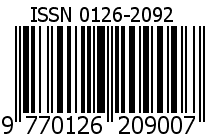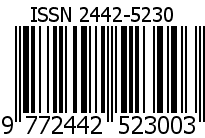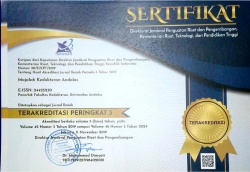Time and Concentration-dependent Cytotoxicity of Piperine on Hela Cells
Abstract
Piperine, the primary alkaloid of Piper nigrum and Piper longum, is believed to have anticancer properties. Although research on cervical cancer is still in its early stages, piperine's anticancer capabilities have been established in numerous types of cancer and have been shown to target pathways involved in the cell cycle and apoptosis. This study aims to determine how piperine administration time and concentration affect the viability of Hela cells. The MTT method was used to conduct this study. The concentration of piperine utilized was 1,000; 500; 250; 125, and 62.5 µg/mL, and it was administered for 24 and 48 hours. The IC50 values, obtained after incubation for 24 and 48 hours, were 711.21 µg/mL and 419.75 µg/mL, respectively. We may conclude that the viability of HeLa cells is influenced by piperine in a time- and concentration-dependent manner (p<0.05).
Keywords
Full Text:
PDFReferences
Bray F, Ferlay J, Soerjomataram I, Siegel RL, Torre LA, Jemal A. Global cancer statistics 2018: GLOBOCAN estimates of incidence and mortality worldwide for 36 cancers in 185 countries. CA Cancer J Clin. 2018;68(6):394–424.
Bruni L, Albero G, Serrano B, Mena M, Gómez D, Muñoz J, et al. Human Papillomavirus and Related Diseases Report. ICO/IARC Inf Cent HPVand Cancer (HPV Inf Centre) [Internet]. 2019;(January):307. Available from: https://hpvcentre.net/statistics/reports/XWX.pdf
Olusola P, Banerjee HN, Philley J V., Dasgupta S. Human Papilloma Virus-Associated Cervical Cancer and Health Disparities. Cells. 2019;8(6):622.
Graham S V. Keratinocyte differentiation-dependent human papillomavirus gene regulation. Viruses. 2017;9(245):1–18.
Doorbar J, Egawa N, Griffin H, Kranjec C, Murakami I. Human papillomavirus molecular biology and disease association. Rev Med Virol. 2016;25(1):2–23.
McLaughlin-Daurbin ME. Oncogenic Activities of Human Papillomaviruses Margaret. 2014;71(11):3831–40.
Lim JS, Lee DY, Lim JH, Oh WK, Park JT, Park SC, et al. Piperine: An Anticancer and Senostatic Drug. Front Biosci - Landmark. 2022;27(4):1–9.
Kakarala M, Brenner DE, Korkaya H, Cheng C, Tazi K, Ginestier C, et al. Targeting breast stem cells with the cancer-preventive compounds curcumin and piperine. Breast Cancer Res Treat. 2010;122(3):777–85.
Lai L hua, Fu Q hong, Liu Y, Jiang K, Guo Q ming, Chen Q yun, et al. Piperine suppresses tumor growth and metastasis in vitro and in vivo in a 4T1 murine breast cancer model. Nat Publ Gr [Internet]. 2012;523–30. Available from: http://dx.doi.org/10.1038/aps.2011.209
Rather RA, Bhagat M. Cancer Chemoprevention and Piperine : Molecular Mechanisms and Therapeutic Opportunities. 2018;6(February):1–12.
Fridman JS, Lowe SW. Control of apoptosis by p53. Oncogene. 2003;22(56 REV. ISS. 8):9030–40.
Turrini E, Sestili P, Fimognari C. Overview of the Anticancer Potential of the “King of Spices” Piper nigrum and Its Main Constituent Piperine. Toxins (Basel). 2020;12(12).
Adan A, Kiraz Y, Baran Y. The international international journal journal for timely for timely in-depth reviews in in-depth reviews in Pharmaceutical Pharmaceutical Biotechnology Impact Factor: 1.802 BENTHAM. Curr Biotechnol Pharm. 2016;17(14):1873–4316.
Kamiloglu S, Sari G, Ozdal T, Capanoglu E. Guidelines for cell viability assays. Food Front. 2020;1(3):332–49.
Van Tonder A, Joubert AM, Cromarty AD. Limitations of the 3-(4,5-dimethylthiazol-2-yl)-2,5-diphenyl-2H-tetrazolium bromide (MTT) assay when compared to three commonly used cell enumeration assays. BMC Res Notes. 2015;8(1):1–10.
Ghasemi M, Turnbull T, Sebastian S, Kempson I. The mtt assay: Utility, limitations, pitfalls, and interpretation in bulk and single-cell analysis. Int J Mol Sci. 2021;22(23).
Widiandani T, Tandian T, Zufar BD, Suryadi A, Purwanto BT, Hardjono S, et al. In vitro study of pinostrobin propionate and pinostrobin butyrate: Cytotoxic activity against breast cancer cell T47D and its selectivity index. J Public Health Africa. 2023;14(S1):97–102.
Stockert JC, Horobin RW, Colombo LL, Blázquez-Castro A. Tetrazolium salts and formazan products in Cell Biology: Viability assessment, fluorescence imaging, and labeling perspectives. Acta Histochem [Internet]. 2018;120(3):159–67. Available from: http://dx.doi.org/10.1016/j.acthis.2018.02.005
Srivastava AK, Singh VK. Biological action of Piper nigrum - the king of spices. Eur J Biol Res. 2017;7(3):223–33.





















